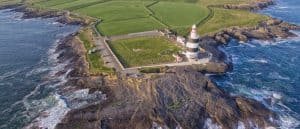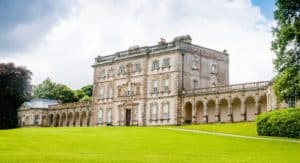Origins and Tales of Irish Folklore Behind Famous Landmarks

Updated On: April 23, 2024 by Eman Sameh
Ireland’s landscapes are steeped in myths and legends, each landmark holding a story that has been passed down through generations. Deeper than mere tales, Irish folklore forms an essential part of the national identity, weaving the threads of the past into the very fabric of the present. The folklore behind Ireland’s famous landmarks is not just entertainment; it provides valuable insights into the culture and customs that have shaped Irish life. From the Giant’s Causeway to the legendary Hill of Tara, the tales associated with these sites are as captivating as the landmarks themselves.

Our exploration takes us beyond the picturesque vistas into the realm of the Aos Sí, the mythical creatures and deities that roam the Irish countryside. The narrative embedded in each site encapsulates the essence of Irish folklore—the heroics of characters such as Cú Chulainn and the spiritual wisdom symbolised by artefacts like the shamrock. These stories are more than fiction; they are vessels of morality and wisdom, serving as a bridge between the ancient and modern worlds, helping us to understand the unseen and appreciate the mystical heritage that Ireland proudly preserves.
Irish folklore isn’t solely an item of historical curiosity; it remains a living tradition that continues influencing contemporary culture and thought. Our journey through these stories not only honours the past but also ensures their conservation for generations to come. By delving into the folklore behind Ireland’s famous landmarks, we embrace a legacy that is an intrinsic part of our cultural tapestry.
The Essence of Irish Folklore

Irish folklore is a tapestry woven from the threads of myths and characters that have permeated our identity for centuries. With storytelling at its heart, this vibrant tradition is ever-present in Ireland’s cultural landscape.
Irish Mythology and Its Origins
Our mythology traces back to pre-Christian times, rooted in oral traditions and later transcribed by Christian monks. This has provided us with many tales featuring gods, goddesses, and mystical creatures, many of which are intrinsically tied to our physical landmarks. The seanchaí, or traditional Irish storytellers, kept these narratives alive, imparting knowledge and entertaining communities with each retelling.
- Tuatha Dé Danann: A race of supernatural beings representing pre-Christian Gaelic Ireland’s main deities.
- Fionn mac Cumhaill: A legendary warrior whose stories include the famous Salmon of Knowledge.
Folklore’s Role in Irish Identity
Folklore is the essence through which we understand our past, our land, and ourselves. It serves as a cultural memory bank, a collection of communal knowledge that forms a key part of what it means to be Irish. In essence, the legacy of folklore perpetuates Irish identity:
- Cultural Unity: Connection through shared stories and traditional lore.
- Moral Framework: Fables often carry underlying moral lessons and reflections on society.
Legendary Figures of Irish Mythology

In this section, we’ll explore the epic tales of heroes and mystical beings that are woven into the fabric of Ireland’s magnificent landmarks.
Fionn Mac Cumhail and the Fianna
Fionn Mac Cumhail, also known as Finn MacCool, is a celebrated warrior in Irish folklore. Leader of the Fianna, a band of noble warriors, he’s known for his wisdom and might. Fionn’s adventures, many involving the Salmon of Knowledge, which granted him all the world’s wisdom by just a taste, are legendary. Fionn’s association with the Giant’s Causeway, a stunning geological formation on the northern coast, adds a magical dimension to this natural wonder—with tales describing it as the remains of a causeway built by Fionn to challenge a Scottish giant.
The Heroic Cú Chulainn
The fearsome Cú Chulainn is one of the most formidable figures in Irish mythology. His story is central to the Ulster Cycle, one of the four main cycles of Irish myth. Cú Chulainn attained legendary status as a hero from a young age, famed for his superhuman abilities and his near-invincible fighting skills. His most famous adventure, the Táin Bó Cúailnge (Cattle Raid of Cooley), highlights his strength and valour as he defends Ulster against overwhelming forces.
The Enigmatic Fairies and Leprechauns
Fairies and leprechauns are perhaps the most enchanting elements of Irish folklore. The fairies, known as the Aos Sí or Tuatha Dé Danann, are said to inhabit a parallel world to ours, living in fairy mounds that dot the Irish countryside. These mystical beings play a crucial role in many Irish tales, where they often interact with humans, for better or for worse. On the other hand, leprechauns, shoemaking fairies notorious for their mischief, are synonymous with good fortune and emblematic Irish luck. Despite their elusive nature, these tiny creatures and their pots of gold are deeply rooted in the mythological landscape of Ireland.
Salient Landmarks and Their Lore

Ireland’s terrain is woven with tales that blend the natural and supernatural. Our exploration uncovers the folklore etched into Irish landscapes, from the hexagonal columns of the Giant’s Causeway to the historic depths of Dublin and the epic narratives of the Ulster Cycle.
The Enchantment of the Giant’s Causeway
The Giant’s Causeway, with its interlocking basalt columns, is not just a geological wonder but also a storied canvas. Legend speaks of the Irish giant Finn McCool, building the causeway to stride across the sea to Scotland. These stones in County Antrim are a testament to Ireland’s storied tradition, marrying the majesty of landscapes with the richness of myth.
Mysteries of Dublin’s Ancient Sites
Dublin, rich with history, houses ancient sites amid its vibrant streets. Stories from medieval castles to the storied halls of Trinity College invite us to unravel centuries of lore. Within these storied stone walls, hushed whispers of Ireland’s past converge with the bustle of the modern city.
Ulster Cycle and Northern Ireland
In Northern Ireland, the legendary tales of the Ulster Cycle echo through the hills. This heroic saga features warriors and kings whose deeds are immortalised in places like Emain Macha (Navan Fort), adding a breath of enigma to the ancient landscapes. Our collective memory cherishes these sites, as they continue to inspire and intrigue.
Sacred Symbols and Artefacts in Folk Stories
In Irish folklore, certain symbols and artefacts are endowed with rich spiritual significance, often interweaving into stories that have been told for generations. These items carry with them not just tales of old but also deeply-held spiritual beliefs and cultural practices.
The Harp and Its Melodious Tales
The harp stands out as a poignant emblem of Irish identity, revered for its elegant form and the enchanting music it produces. This instrument figures prominently in myth, where it is sometimes associated with the mythical tale of the Salmon of Knowledge. The story tells of a magical fish from which the harpist might gain all the world’s knowledge through the act of playing. Such artefacts in our folklore aren’t just for entertainment; they’re lauded as gateways to the wisdom of the ancients, turning musicians into custodians of history and lore.
Shamrock and It’s Holy Trinity
Shamrocks hold a unique space in Irish folklore, where they symbolise the Holy Trinity due to their three-leaved shape. This simple plant transcends its botanical nature to embody a concept that’s central to Ireland’s spiritual heritage. In many stories, the shamrock is a motif that offers protection and enlightenment. Its significance is a testament to how an ordinary object can become a potent symbol intertwined with the fabric of our cultural and spiritual beliefs.
The Unseen World: Aos Sí and Other Creatures

Embark on a mystical journey with us as we uncover the folklore of Ireland’s most iconic landmarks, home to the elusive Aos Sí and a host of other mythical beings that have captivated minds for centuries.
The Enigmatic Aos Sí
The Aos Sí, spiritual descendants of the Tuatha Dé Danann, reside within the Irish landscape in places unseen, such as fairy hills and ancient monuments. These supernatural beings are deeply woven into Irish folklore, often portrayed as custodians of nature and masterful shapeshifters. An iconic representation of this connection can be found in fairy trees, solitary hawthorns standing in fields, said to be sacred to the Aos Sí and perilous for mortals to disturb.
In the lush countryside, the pooka—a mischievous shape-shifter—emerges after nightfall. As another aspect of the Aos Sí family, pooka is known to spoil berries and interact with rural inhabitants in various guises, from a dark, wild horse to a goblin-like creature.
Tales of Banshees and Otherworldly Beings
Among the most notorious of Irish folklore are the banshees, solitary female spirits whose mournful wails foretell death. These ethereal figures are believed to be associated with particular families and are known to lurk near historical sites or roam the countryside.
Another eerie entity is the changeling, an infant believed to be substituted by the Aos Sí for a human child. The changeling tale cautions against the crossing of boundaries between the human world and that of the fairy folk, with folklore filled with tales of abductions and exchanges performed by these otherworldly creatures.
Our landscape is not just soil and stone; it is a tapestry of stories and whispers of the past, where every glen and grove might hide wonders. We invite you to look closer and listen; maybe you’ll catch a glimpse of the mystical Aos Sí or hear the distant lament of a banshee on the wind.
The Cultural Tapestry of Irish Mythology
In our exploration of the Cultural Tapestry of Irish Mythology, we uncover the symbiotic relationship between the lore of the Emerald Isle and its expressions through music, dance, and the Irish language.
Music and Dance in Irish Legends
Irish mythology often interweaves with Irish music and dance, forming a rich narrative thread that echoes through the ages. The realm of the Sidhe, mystical beings from Irish folklore, inspires lively tunes that mirror the otherworldly dances described in legends. These musical traditions, deeply rooted in Celtic mythology, have been passed down through oral traditions, ensuring the continuity of these ancient stories. The essence of these legends is captured in the haunting melodies of the tin whistle and the rhythmic tapping of traditional Irish dance forms like jigs and reels.
Language and Myth: The Impact of Gaelic
The Gaelic language itself is a vessel for the old myths, with countless tales immortalised in its lexicon. Irish mythology and Gaelic are intricately linked; many mythological characters and their stories are found within the language, reflecting the power of words to sustain culture. From the heroic sagas of old to the expressions of daily life, the Gaelic language endures as a living testament to Ireland’s storied past. It plays a crucial role in not just preserving these tales but infusing them into the very fabric of Irish identity.
Folktales as Vessels of Wisdom and Morality

Folktales have long served as conduits for imparting wisdom and ethical guidelines. These narratives, steeped in cultural tradition, often reflect the values of the society from which they originate.
Lessons from the Children of Lir
The poignant tale of the Children of Lir holds enduring lessons about the pain of betrayal and the power of enduring love. In this Irish legend, four siblings are transformed into swans by their jealous stepmother, confined to centuries of wandering across various water bodies of Ireland. Only the sound of a bell and the embrace of Christianity can free them. This story teaches us the virtue of patience amidst suffering and the hope for redemption.
Moral Tales of Macha and the Morrigan
Macha and the Morrigan, figures from Irish mythology, embody the complexities of life’s trials and the sovereignty of the land. Macha cursed to race against horses while in labour, after winning, imposes a curse on the men of Ulster to feel her labour pains in their time of need. The Morrigan, a goddess of war and fate, presents the inevitability of life’s cyclical nature and the importance of understanding our place within it, thus offering wisdom in the face of our mortality.
Transformations and Crossing Realms

In Irish folklore, physical landscapes often conceal entrances to otherworldly realms where supernatural beings possess the power to transform and cross between worlds.
Shape-Shifters and Changelings
Irish folklore brims with tales of shape-changers, individuals who can alter their appearance, blending human and animal forms. Prominent in these narratives is the Puca, a feared and respected figure capable of taking multiple forms. Stories from the heart of the Irish countryside often whisper of changelings—fairy children left in the place of human infants. These entities serve as a bridge between our world and the mystical, leaving families with a being from the Otherworld.
Journeys Between Worlds
The capacity to move between worlds is a powerful theme in Irish lore. This passage often involves crossing through thresholds hidden within the Irish landscape, like ancient Sidhe mounds or mist-covered lakes. Folklore recounts how heroes and adventurers journey to the Otherworld, receiving messages and warnings for the mortal realm. Such tales serve not only to entertain but also to transmit values and knowledge about the limits of human understanding and the vastness of the Otherworld.
Folklore’s Influence on Contemporary Culture

In this section, we will explore how Irish folklore has woven its way into the very fabric of modern culture globally, implicitly guiding forms of art and literature.
Global Reach of Irish Folk Stories
Irish folklore has remarkably travelled beyond its native shores, significantly influencing cultures and generations worldwide. Our customs and stories, rich with mythological creatures and epic sagas, have captivated audiences far and wide, emphasising the power of Irish culture in today’s interconnected world. For instance, St. Patrick’s Day, a cultural and religious celebration held on 17 March, has become a global phenomenon, commemorating Irish heritage with parades, dancing, and storytelling around the world.
Knowledge of these tales is not just confined to storytelling but extends into many areas of contemporary life, from theatre productions to online platforms, like Connolly Cove, which spreads Irish cultural insights internationally, enriching global understanding of Ireland’s folklore traditions.
Relevance in Modern Art and Literature
In the realm of art and literature, the ancient motifs of Irish stories remain prevalent. Influences are evident in literature with references steeped in folklore, breathing new life into cherished beliefs and legendary characters for today’s readers. Contemporary authors have often drawn upon these age-old tales, artistically transforming them to resonate with the present generation.
Works of art and music frequently pay homage to the mystical elements found within Irish stories, imbuing them with a contemporary twist yet retaining their traditional essence. These creative expressions continue to celebrate Irish culture, ensuring that the legacy of our ancestral narratives is preserved and continues to flourish within modern customs.
Conservation of Folklore in Modern Times
In modern times, the conservation of Ireland’s rich folkloric tapestry remains as significant as ever. Efforts to preserve this cultural heritage adapt to contemporary mediums, ensuring that the stories of old continue to resonate with future generations.
Preserving Oral Traditions
The art of seanchaí, or traditional Irish storytelling, has been a vital method of preserving history and folklore for centuries. Orally passed from generation to generation, these stories encapsulate the morals, beliefs, and history of the Irish people. Conservation of these methods includes recording the skills of storytellers to maintain this timeless tradition in its most authentic form.
The Digital Age and Irish Folklore
The onset of the digital age has ushered in new modalities for preserving and disseminating Irish folklore. Digital archives and online platforms serve as contemporary hearths where tales and lessons of yore find new life. Websites like Connolly Cove now play a crucial role in the conservation of folklore by bringing Irish stories and cultural insights to a global audience. Through these means, Ireland’s legendary past remains an accessible and enduring part of the digital landscape.
Frequently Asked Questions

In this section, we explore the rich tapestry of legends associated with various Irish landmarks. From the Giant’s Causeway, steeped in mythical tales, to the eerie legends of banshees connected to ancient sites, we illuminate the folklore intertwined with Ireland’s natural wonders and historic castles.
What are the stories associated with the Giant’s Causeway?
The Giant’s Causeway is renowned for its mythological origins involving the giant Finn McCool. Legend has it that McCool created the causeway as stepping stones to Scotland to confront his rival, Benandonner.
Who are the prominent figures in Irish folklore?
Prominent figures in Irish folklore include the likes of Cú Chulainn, a hero known for his superhuman abilities and the enigmatic Morrígan, associated with war and fate. Fae creatures like leprechauns also hold a celebrated place in the myths.
Which Irish landmark is connected to the legend of the banshee?
The Banshee, a foreteller of death with a piercing wail, is often linked to the stronghold of Ross Castle. This sentinel on the shores of Lough Leane is shrouded in tales of this mournful spirit.
How do Irish fairy tales influence the perception of Ireland’s natural sites?
Irish fairy tales shape perceptions of natural sites as enigmatic and spirit-filled landscapes. Many fairy tales involve interactions with the “Otherworld”, presenting natural sites as gateways to realms beyond our own.
What are the origins of the leprechaun myths at Carlingford Mountain?
Carlingford Mountain is famously associated with leprechaun folklore, where these solitary and mischievous fairies are thought to have buried their pots of gold, outfoxing all who seek their fortune.
Can you explore the links between famous Irish castles and ghost stories?
Irish castles are often the settings for ghost stories; Leap Castle is infamous for being haunted, with numerous spirits claimed to roam its ancient halls, including the bloodthirsty elemental known only as ‘It’.






